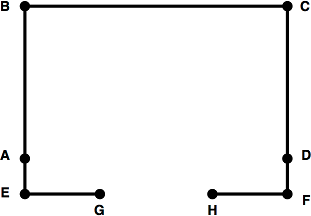Trail Blazing
You are trying to plan a path for a vehicle moving through an environment without obstacles. The environment has several cities, some of which are connected by straight roads. The vehicle starts at a city A and has to move to another city D. It can travel on-road or off-road. If it goes on a road of length d, then the cost is d. If it goes off-road for a distance d, then the cost is 2d.
Here is an example world, with lines indicating roads, and a matrix of Euclidean ("airline") distances between each pair of cities (this figure is drawn to scale):

We assume that when moving between one city and another, the vehicle uses the road if it is available on its direct path. So, for example:
- The cost from E to A is $1$
- The cost from E to F is $10 = \hbox{dist}(EG) + 2\cdot\hbox{dist}(GH) + \hbox{dist}(HF)$
- The cost from E to D is $14.2 = 2\cdot\hbox{dist}(ED)$
Cost
Depth-First with DP
Some assumptions for this part:
- The AD off-road path is not allowed; all other paths on and off road are allowed.
- The successors (children) of a state are pushed onto the agenda in REVERSE ALPHABETICAL order.
Breadth First with DP
Some assumptions for this part:
- The AD off-road path is not allowed; all other paths on and off road are allowed.
- The successors (children) of a state are pushed onto the agenda in ALPHABETICAL order.
Uniform Cost with DP
Some assumptions for this part:
- All paths on and off road are allowed.
- The successors (children) of a state are pushed into the agenda in ALPHABETICAL order.